Muscle Contractile Properties Measured by the Tensiomyography (TMG) Method in Top-Level Football Players of Different Playing Positions: The Case of Serbian Super League
Abstract
1. Introduction
2. Materials and Methods
2.1. Subjects
2.2. Procedures
2.3. Statistical Analyses
3. Results
4. Discussion
5. Conclusions
Author Contributions
Funding
Institutional Review Board Statement
Informed Consent Statement
Data Availability Statement
Conflicts of Interest
References
- Drust, B.; Atkinson, G.; Reilly, T. Future perspectives in the evaluation of the physiological demands of soccer. Sport. Med. 2007, 37, 783. [Google Scholar] [CrossRef] [PubMed]
- Slimani, M.; Nikolaidis, P. Anthropometric and physiological characteristics of male Soccer players according to their competitive level, playing position and age group: A systematic review. J. Sport. Med. 2017, 59, 141–163. [Google Scholar] [CrossRef] [PubMed]
- Gil, S.M.; Gil, J.; Ruiz, F.; Irazusta, A.; Irazusta, J. Physiological and anthropometric characteristics of young soccer players according to their playing position: Relevance for the selection process. J. Strength Cond. Res. 2007, 21, 438–445. [Google Scholar] [CrossRef] [PubMed]
- Nikolaidis, P.; Ziv, G.; Lidor, R.; Arnon, M. Inter-individual variability in soccer players of different age groups playing different positions. J. Hum. Kinet. 2014, 40, 213. [Google Scholar] [CrossRef]
- Sutton, L.; Scott, M.; Wallace, J.; Reilly, T. Body composition of English Premier League soccer players: Influence of playing position, international status, and ethnicity. J. Sport. Sci. 2009, 27, 1019–1026. [Google Scholar] [CrossRef] [PubMed]
- Lago-Peñas, C.; Casais, L.; Dellal, A.; Rey, E.; Domínguez, E. Anthropometric and physiological characteristics of young soccer players according to their playing positions: Relevance for competition success. J. Strength Cond. Res. 2011, 25, 3358–3367. [Google Scholar] [CrossRef]
- Hencken, C.; White, C. Anthropometric assessment of Premiership soccer players in relation to playing position. Eur. J. Sport Sci. 2006, 6, 205–211. [Google Scholar] [CrossRef]
- Arnason, A.; Sigurdsson, S.B.; Gudmundsson, A.; Holme, I.; Engebretsen, L.; Bahr, R. Physical fitness, injuries, and team performance in soccer. Med. Sci. Sport. Exerc. 2004, 36, 278–285. [Google Scholar] [CrossRef]
- Aziz, A.R.; Mukherjee, S.; Chia, M.Y.H.; Teh, K.C. Validity of the running repeated sprint ability test among playing positions and level of competitiveness in trained soccer players. Int. J. Sport. Med. 2008, 29, 833–838. [Google Scholar] [CrossRef] [PubMed]
- Kaplan, T. Examination of repeated sprinting ability and fatigue index of soccer players according to their positions. J. Strength Cond. Res. 2010, 24, 1495–1501. [Google Scholar] [CrossRef]
- Jadczak, Ł.; Grygorowicz, M.; Wieczorek, A.; Śliwowski, R. Analysis of static balance performance and dynamic postural priority according to playing position in elite soccer players. Gait Posture 2019, 74, 148–153. [Google Scholar] [CrossRef] [PubMed]
- Śliwowski, R.; Grygorowicz, M.; Hojszyk, R.; Jadczak, Ł. The isokinetic strength profile of elite soccer players according to playing position. PLoS ONE 2017, 12, e0182177. [Google Scholar] [CrossRef] [PubMed]
- Ruas, C.V.; Minozzo, F.; Pinto, M.D.; Brown, L.E.; Pinto, R.S. Lower-extremity strength ratios of professional soccer players according to field position. J. Strength Cond. Res. 2015, 29, 1220–1226. [Google Scholar] [CrossRef] [PubMed]
- Sporis, G.; Jukic, I.; Ostojic, S.M.; Milanovic, D. Fitness profiling in soccer: Physical and physiologic characteristics of elite players. J. Strength Cond. Res. 2009, 23, 1947–1953. [Google Scholar] [CrossRef] [PubMed]
- Rey, E.; Penas, C.L.; Ballesteros, J.L. Tensiomyography of selected lower-limb muscles in professional soccer players. J. Electromyogr. Kinesiol. 2012, 22, 866–872. [Google Scholar] [CrossRef] [PubMed]
- Paravlic, A.H.; Milanović, Z.; Abazović, E.; Vučković, G.; Spudić, D.; Rošker, Z.M.; Vodičar, J. The muscle contractile properties in female soccer players: Inter-limb comparison using tensiomyography. J. Musculoskelet Neuronal Interact. 2022, 22, 179–192. [Google Scholar]
- García-García, O.; Serrano-Gómez, V.; Hernández-Mendo, A.; Morales-Sánchez, V. Baseline mechanical and neuromuscular profile of knee extensor and flexor muscles in professional soccer players at the start of the preseason. J. Hum. Kinet. 2017, 58, 23–34. [Google Scholar] [CrossRef][Green Version]
- Macgregor, L.J.; Hunter, A.M.; Orizio, C.; Fairweather, M.M.; Ditroilo, M. Assessment of skeletal muscle contractile properties by radial displacement: The case for tensiomyography. Sport. Med. 2018, 48, 1607–1620. [Google Scholar] [CrossRef]
- Martín-Rodríguez, S.; Loturco, I.; Hunter, A.M.; Rodríguez-Ruiz, D.; Munguia-Izquierdo, D. Reliability and measurement error of tensiomyography to assess mechanical muscle function: A systematic review. J. Strength Cond. Res. 2017, 31, 3524–3526. [Google Scholar] [CrossRef]
- Valencic, V.; Knez, N. Measuring of skeletal muscles’ dynamic properties. Artif. Organs. 1997, 21, 240–242. [Google Scholar] [CrossRef]
- Križaj, D.; Šimunič, B.; Žagar, T. Short-term repeatability of parameters extracted from radial displacement of muscle belly. J. Electromyogr. Kinesiol. 2008, 18, 645–651. [Google Scholar] [CrossRef] [PubMed]
- Alvarez-Diaz, P.; Alentorn Geli, E.; Ramon, S.; Marin, M.; Steinbacher, G.; Rius, M.; Cugat, R. Effects of anterior cruciate ligament reconstruction on neuromuscular tensiomyographic characteristics of the lower extremity in competitive male soccer players. Knee Surg. Sport. Traumatol. Arthrosc. 2015, 23, 3407–3413. [Google Scholar] [CrossRef] [PubMed]
- Alvarez-Diaz, P.; Alentorn-Geli, E.; Ramon, S.; Marin, M.; Steinbacher, G.; Rius, M.; Cugat, R. Comparison of tensiomyographic neuromuscular characteristics between muscles of the dominant and non-dominant lower extremity in male soccer players. Knee Surg. Sport. Traumatol. Arthrosc. 2016, 24, 2259–2263. [Google Scholar] [CrossRef] [PubMed]
- Alvarez-Diaz, P.; Alentorn-Geli, E.; Ramon, S.; Marin, M.; Steinbacher, G.; Boffa, J.J.; Cugat, R. Effects of anterior cruciate ligament injury on neuromuscular tensiomyographic characteristics of the lower extremity in competitive male soccer players. Knee Surg. Sport. Traumatol. Arthrosc. 2016, 24, 2264–2270. [Google Scholar] [CrossRef] [PubMed]
- Alentorn-Geli, E.; Alvarez-Diaz, P.; Ramon, S.; Marin, M.; Steinbacher, G.; Boffa, J.J.; Cusco, X.; Ballester, J.; Cugat, R. Assessment of neuromuscular risk factors for anterior cruciate ligament injury through tensiomyography in male soccer players. Knee Surg. Sport. Traumatol. Arthrosc. 2015, 23, 2508–2513. [Google Scholar] [CrossRef] [PubMed]
- Alentorn-Geli, E.; Alvarez-Diaz, P.; Ramon, S.; Marin, M.; Steinbacher, G.; Rius, M.; Seijas, R.; Ares, O.; Cugat, R. Assessment of gastrocnemius tensiomyographic neuromuscular characteristics as risk factors for anterior cruciate ligament injury in male soccer players. Knee Surg. Sport. Traumatol. Arthrosc. 2015, 23, 2502–2507. [Google Scholar] [CrossRef] [PubMed]
- Đorđević, S.; Rozman, S.; Zupet, P.; Dopsaj, M.; Maffulli, N. Tensiomyography Allows to Discriminate between Injured and Non-Injured Biceps Femoris Muscle. Biology 2022, 11, 746. [Google Scholar] [CrossRef] [PubMed]
- García-García, O.; Serrano-Gomez, V.; Hernandez-Mendo, A.; Tapia-Flores, A. Assessment of the in-season changes in mechanical and neuromuscular characteristics in professional soccer players. J. Sport. Med. 2016, 56, 714–723. [Google Scholar]
- García-Manso, J.M.; Rodríguez-Matoso, D.; Rodríguez-Ruiz, D.; Sarmiento, S.; de Saa, Y.; Calderón, J. Effect of cold-water immersion on skeletal muscle contractile properties in soccer players. Am. J. Phys. Med. Rehabil. 2011, 90, 356–363. [Google Scholar] [CrossRef]
- Gil, S.; Loturco, I.; Tricoli, V.; Ugrinowitsch, C.; Kobal, R.; Cal Abad, C.C.; Roschel, H. Tensiomyography parameters and jumping and sprinting performance in Brazilian elite soccer players. Sport. Biomech. 2015, 14, 340–350. [Google Scholar] [CrossRef]
- Loturco, I.; Pereira, L.A.; Kobal, R.; Kitamura, K.; Ramírez-Campillo, R.; Zanetti, V.; Nakamura, F.Y. Muscle contraction velocity: A suitable approach to analyze the functional adaptations in elite soccer players. J. Sport. Sci. Med. 2016, 15, 483. [Google Scholar]
- Reilly, T.; Bangsbo, J.; Franks, A. Anthropometric and physiological predispositions for elite soccer. J. Sport. Sci. 2000, 18, 669–683. [Google Scholar] [CrossRef] [PubMed]
- Young, W.B.; Rath, D.A. Enhancing foot velocity in football kicking: The role of strength training. J. Strength Cond. Res. 2011, 25, 561–566. [Google Scholar] [CrossRef] [PubMed]
- Toskić, L.; Dopsaj, M.; Stanković, V.; Marković, M. Concurrent and predictive validity of isokinetic dynamometry and tensiomyography in differently trained women and men. Isokinet Exerc. Sci. 2019, 27, 31–39. [Google Scholar] [CrossRef]
- Toskić, L.; Dopsaj, M.; Marković, M.; Toskić, D.; Ignjatović, A. Mechanical and contractile properties of knee joint muscles measured by the method of tensiomyography in differently trained men and women. J. Strength Cond. Res. 2022, 36, 1532–1539. [Google Scholar] [CrossRef] [PubMed]
- Jeknić, V.; Dopsaj, M.; Toskić, L.; Koropanovski, N. Muscle contraction adaptations in top-level karate athletes assessed by tensiomyography. Int. J. Environ. Res. Public Health 2022, 19, 10309. [Google Scholar] [CrossRef]
- de Paula Simola, R.Á.; Raeder, C.; Wiewelhove, T.; Kellmann, M.; Meyer, T.; Pfeiffer, M.; Ferrauti, A. Muscle mechanical properties of strength and endurance athletes and changes after one week of intensive training. J. Electromyogr. Kinesiol. 2016, 30, 73–80. [Google Scholar] [CrossRef]
- Tous-Fajardo, J.; Moras, G.; Rodríguez-Jiménez, S.; Usach, R.; Doutres, D.M.; Maffiuletti, N.A. Inter-rater reliability of muscle contractile property measurements using non-invasive tensiomyography. J. Electromyogr. Kinesiol. 2010, 20, 761–766. [Google Scholar] [CrossRef]
- Hair, J.; Anderson, R.; Tatham, R.; Black, W. Multivariate Data Analysis, 5th ed.; Prentice-Hall. Inc.: Hoboken, NJ, USA, 1998. [Google Scholar]
- Jaric, S. Muscle strength testing. Sport. Med. 2002, 32, 615–631. [Google Scholar] [CrossRef]
- McNair, P.J.; Depledge, J.; Brettkelly, M.; Stanley, S.N. Verbal encouragement: Effects on maximum effort voluntary muscle: Action. Br. J. Sport. Med. 1996, 30, 243–245. [Google Scholar] [CrossRef]
- Šimunič, B.; Degens, H.; Rittweger, J.; Narici, M.; Mekjavic, I.B.; Pišot, R. Noninvasive estimation of myosin heavy chain composition in human skeletal muscle. Med. Sci. Sport. Exerc. 2011, 43, 1619–1625. [Google Scholar] [CrossRef] [PubMed]
- Dahmane, R.; Valenčič, V.; Knez, N.; Eržen, I. Evaluation of the ability to make non-invasive estimation of muscle contractile properties on the basis of the muscle belly response. Med. Biol. Eng. Comput. 2001, 39, 51–55. [Google Scholar] [CrossRef] [PubMed]
- Ju, W.; Doran, D.; Hawkins, R.; Evans, M.; Laws, A.; Bradley, P. Contextualised high-intensity running profiles of elite football players with reference to general and specialised tactical roles. Biol. Sport. 2022, 40, 291–301. [Google Scholar] [CrossRef]
- Di Salvo, V.; Baron, R.; Tschan, H.; Montero, F.C.; Bachl, N.; Pigozzi, F. Performance characteristics according to playing position in elite soccer. Int. J. Sport. Med. 2007, 28, 222–227. [Google Scholar] [CrossRef] [PubMed]
- Modric, T.; Versic, S.; Sekulic, D. Position specific running performances in professional football (soccer): Influence of different tactical formations. Sports 2020, 8, 161. [Google Scholar] [CrossRef] [PubMed]
- Parpa, K.; Michaelides, M. Peak isokinetic Torques of football players participating in different levels in cyprus and lower limb asymmetries. J. Sport. Sci. 2017, 5, 250–255. [Google Scholar]
- Helme, M.; Tee, J.; Emmonds, S.; Low, C. Does lower-limb asymmetry increase injury risk in sport? A systematic review. Phys. Ther. Sport 2021, 49, 204–213. [Google Scholar] [CrossRef]
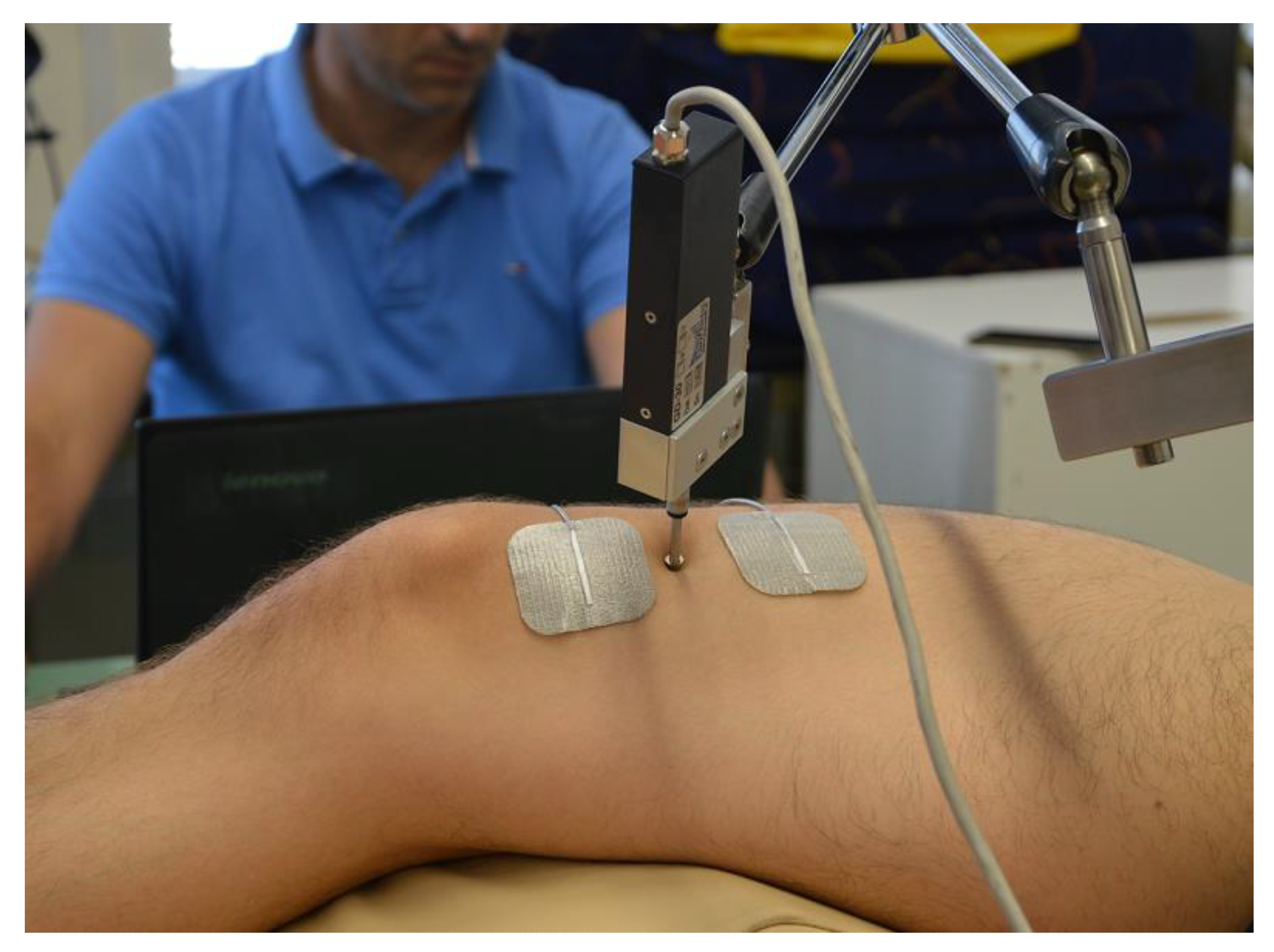
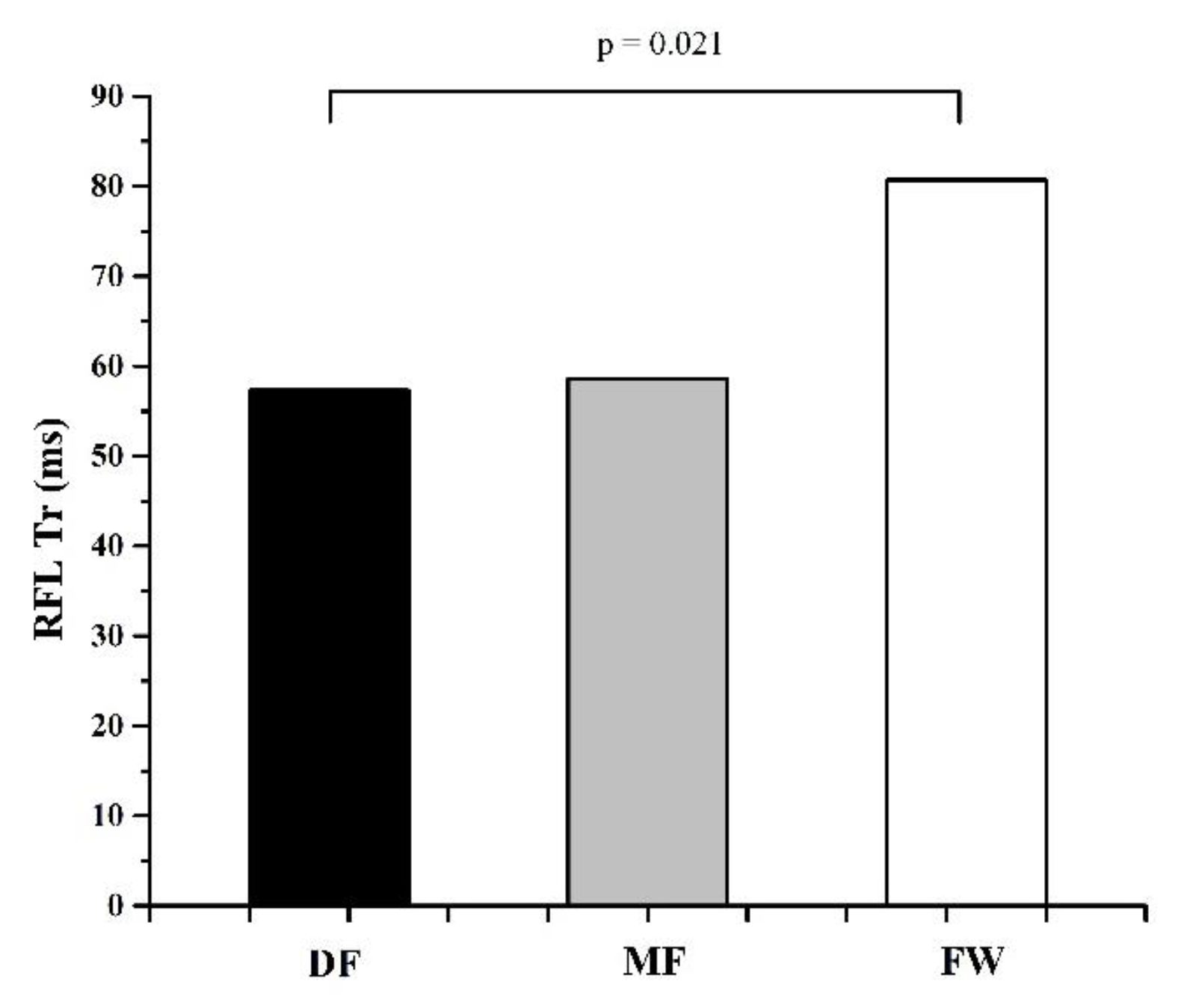
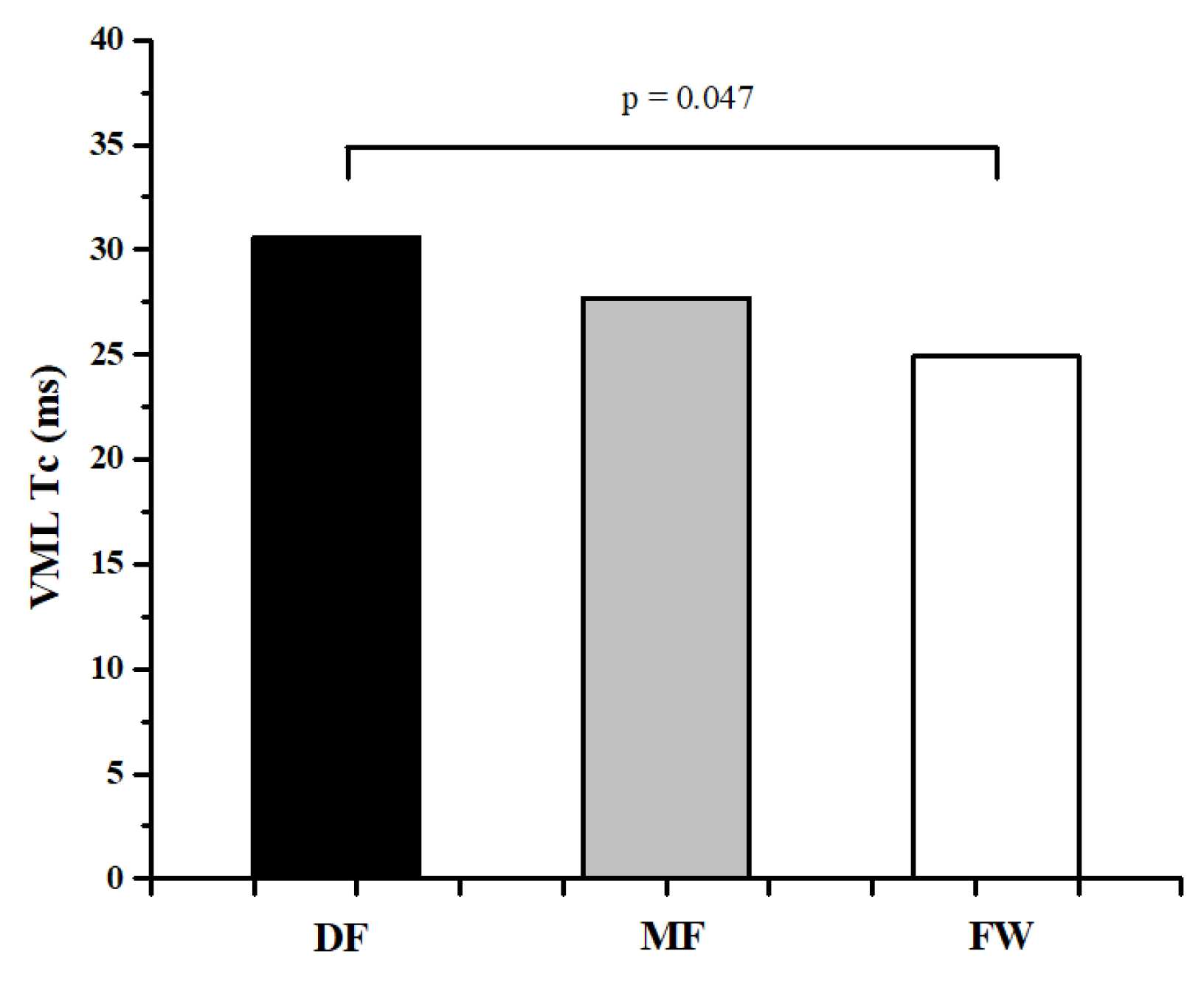
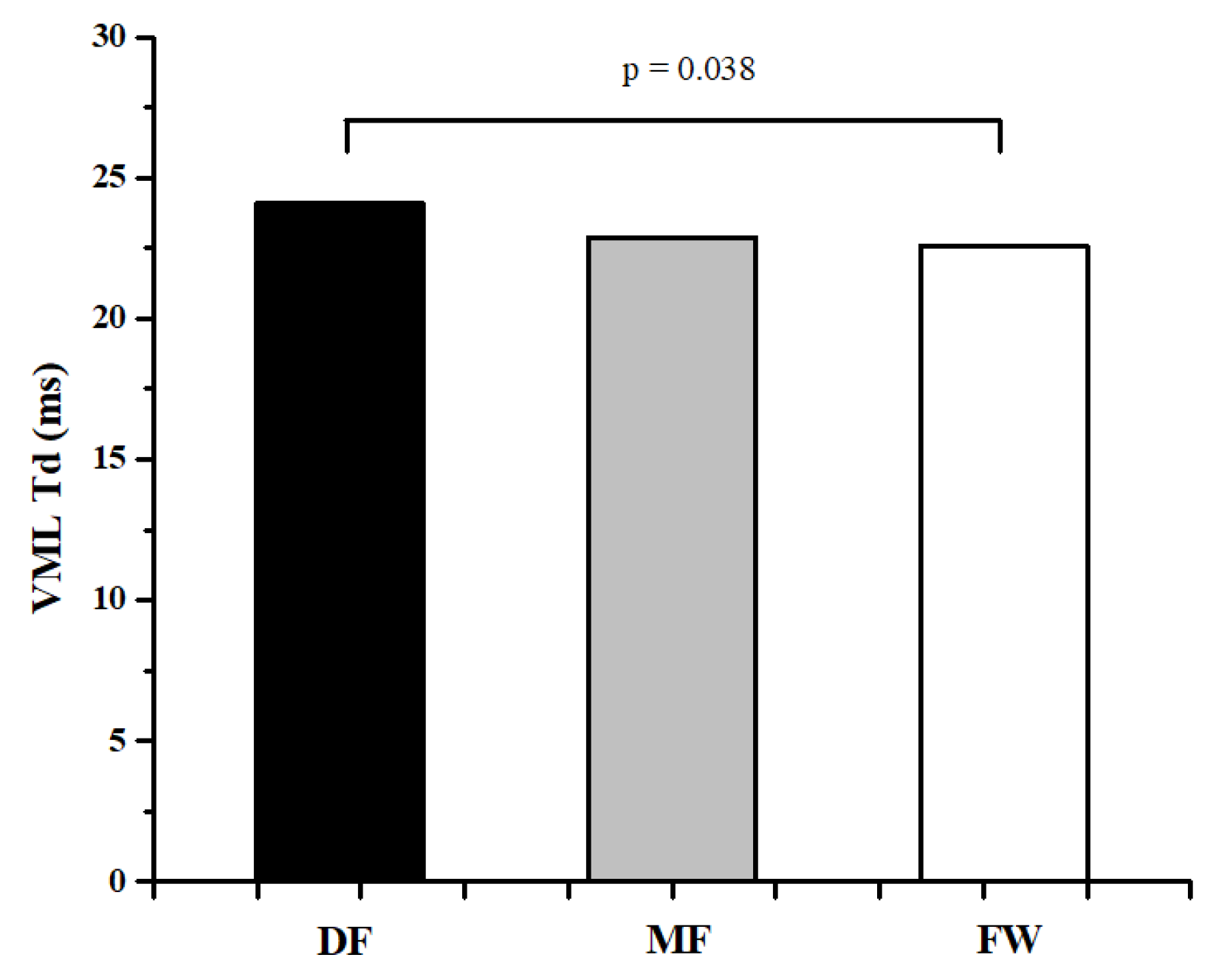

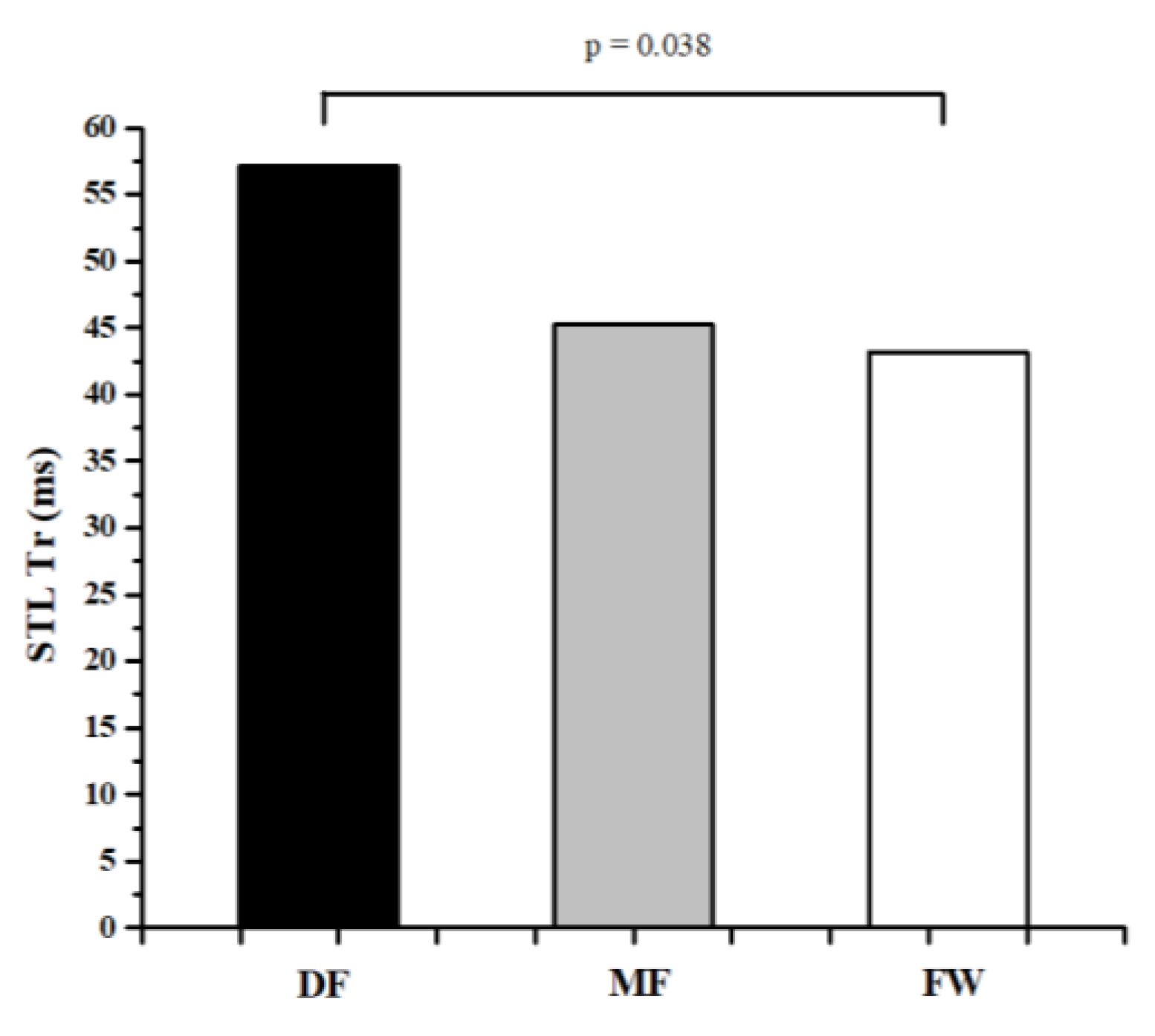
| DF | MF | FW | ANOVA | |||
|---|---|---|---|---|---|---|
| F | p | |||||
| RFR | Tc | 31.1 ± 6.2 | 30.4 ± 5 | 32.3 ± 7.92 | 0.396 | 0.675 |
| Ts | 155.6 ± 89.6 | 132.4 ± 42.4 | 128.02 ± 37.4 | 1.118 | 0.334 | |
| Tr | 70.9 ± 29.5 | 72.7 ± 31.1 | 71.1 ± 32.4 | 0.017 | 0.983 | |
| Dm | 6.37 ± 3 | 6.90 ± 2.45 | 6.79 ± 2.48 | 0.210 | 0.811 | |
| Td | 25.2 ± 4.66 | 23.8 ± 1.91 | 24.4 ± 2.77 | 0.737 | 0.483 | |
| RFL | Tc | 28.2 ± 5.53 | 28.8 ± 5.13 | 28.5 ± 5.25 | 0.043 | 0.958 |
| Ts | 103.6 ± 41.2 | 105.2 ± 42.5 | 123.6 ± 28.4 | 1.736 | 0.186 | |
| Tr | 57.3 ± 30.1 | 58.6 ± 25.6 | 80.7 ± 24.3 | 4.658 | 0.014 | |
| Dm | 5.50 ± 2.18 | 6.43 ± 2.19 | 6.67 ± 2.1 | 1.684 | 0.195 | |
| Td | 23.5 ± 2.03 | 24.2 ± 2.28 | 24.5 ± 2.7 | 1.076 | 0.348 | |
| VMR | Tc | 28.9 ± 6.3 | 28.1 ± 6.03 | 27.4 ± 4.15 | 0.404 | 0.669 |
| Ts | 173.3 ± 23.2 | 177.03 ± 25.6 | 173.8 ± 19.3 | 0.132 | 0.876 | |
| Tr | 44.9 ± 18.9 | 39.8 ± 13.04 | 41.8 ± 13.2 | 0.500 | 0.609 | |
| Dm | 6.13 ± 1.68 | 5.95 ± 1.52 | 5.48 ± 2.04 | 0.723 | 0.490 | |
| Td | 22.3 ± 1.46 | 21.9 ± 1.56 | 22.07 ± 1.66 | 0.305 | 0.738 | |
| VML | Tc | 30.6 ± 10.1 | 27.7 ± 6.18 | 24.9 ± 3.82 | 3.214 | 0.048 |
| Ts | 177.4 ± 29.6 | 178.6 ± 56.8 | 171.7 ± 47.4 | 0.128 | 0.880 | |
| Tr | 45.6 ± 17.6 | 40.2 ± 17.3 | 48.8 ± 37.2 | 0.461 | 0.633 | |
| Dm | 5.93 ± 1.78 | 5.83 ± 1.62 | 5.42 ± 1.81 | 0.482 | 0.620 | |
| Td | 24.1 ± 2.24 | 22.9 ± 1.35 | 22.6 ± 2 | 3.705 | 0.031 | |
| VLR | Tc | 26.9 ± 5.76 | 25.4 ± 5.71 | 24.4 ± 3.67 | 1.332 | 0.273 |
| Ts | 123.9 ± 26.4 | 122.3 ± 34.2 | 122.2 ± 36.3 | 0.018 | 0.982 | |
| Tr | 58.06 ± 13.7 | 57.7 ± 17.2 | 61.5 ± 27.2 | 0.211 | 0.811 | |
| Dm | 4.31 ± 1.64 | 3.97 ± 1.13 | 3.83 ± 1.33 | 0.653 | 0.524 | |
| Td | 24.1 ± 3.72 | 22.8 ± 1.83 | 22.4 ± 1.39 | 2.292 | 0.111 | |
| VLL | Tc | 25.5 ± 3.83 | 24.3 ± 4.17 | 25.1 ± 3.54 | 0.417 | 0.661 |
| Ts | 117.5 ± 28.3 | 123.2 ± 33.9 | 125 ± 28.1 | 0.363 | 0.697 | |
| Tr | 65.8 ± 26.5 | 66.2 ± 27.4 | 59 ± 15.1 | 0.581 | 0.563 | |
| Dm | 4.12 ± 1.52 | 4.38 ± 1.13 | 4.1 ± 1.45 | 0.196 | 0.823 | |
| Td | 26.2 ± 12.8 | 23.7 ± 2.92 | 22.4 ± 1.86 | 1.150 | 0.324 | |
| DF | MF | FW | ANOVA | |||
|---|---|---|---|---|---|---|
| F | p | |||||
| BFR | Tc | 19.5 ± 9.58 | 26.4 ± 15.3 | 23.2 ± 11 | 1.533 | 0.225 |
| Ts | 132.9 ± 92 | 144.2 ± 72.4 | 157.4 ± 84.4 | 0.441 | 0.646 | |
| Tr | 41.7 ± 35.2 | 49.3 ± 30.2 | 41.9 ± 26.6 | 0.326 | 0.723 | |
| Dm | 1.62 ± 1.41 | 2.24 ± 1.53 | 2.77 ± 1.78 | 2.733 | 0.074 | |
| Td | 24.3 ± 24.5 | 19.8 ± 5.17 | 20.5 ± 2.84 | 0.482 | 0.620 | |
| BFL | Tc | 19.8 ± 13.8 | 18.3 ± 12.1 | 20.9 ± 12.9 | 0.193 | 0.825 |
| Ts | 112.2 ± 70.3 | 88.7 ± 53.6 | 132.2 ± 69.3 | 1.859 | 0.166 | |
| Tr | 29.8 ± 28.9 | 18.9 ± 20.2 | 51.1 ± 43.2 | 4.433 | 0.016 | |
| Dm | 1.31 ± 2.16 | 1.31 ± 2.23 | 1.95 ± 2.12 | 0.569 | 0.569 | |
| Td | 24.05 ± 18,9 | 19.7 ± 8.31 | 23.9 ± 17.4 | 0.371 | 0.692 | |
| STR | Tc | 44.9 ± 13.1 | 46.5 ± 13.1 | 44.2 ± 13.01 | 0.139 | 0.870 |
| Ts | 151.4 ± 54.3 | 156.6 ± 30.3 | 147.7 ± 38.1 | 0.179 | 0.837 | |
| Tr | 64.7 ± 42.7 | 51.1 ± 19.2 | 57.1 ± 28.8 | 0.777 | 0.465 | |
| Dm | 4.99 ± 2.9 | 5.97 ± 2.51 | 5.07 ± 2.42 | 0.694 | 0.504 | |
| Td | 26.08 ± 7.13 | 25.3 ± 3.78 | 24.3 ± 4.44 | 0.508 | 0.604 | |
| STL | Tc | 45.7 ± 14.8 | 46.01 ± 16.3 | 45.4 ± 14.6 | 0.005 | 0.995 |
| Ts | 148.7 ± 35.09 | 137.3 ± 42.6 | 139.7 ± 29.1 | 0.565 | 0.572 | |
| Tr | 57.09 ± 20.1 | 45.3 ± 16.4 | 43.2 ± 14.3 | 3.808 | 0.028 | |
| Dm | 5.99 ± 2.88 | 5.93 ± 3.14 | 5.62 ± 2.83 | 0.093 | 0.911 | |
| Td | 25.9 ± 3.61 | 25.8 ± 4.58 | 23.8 ± 3.7 | 1.884 | 0.162 | |
Disclaimer/Publisher’s Note: The statements, opinions and data contained in all publications are solely those of the individual author(s) and contributor(s) and not of MDPI and/or the editor(s). MDPI and/or the editor(s) disclaim responsibility for any injury to people or property resulting from any ideas, methods, instructions or products referred to in the content. |
© 2023 by the authors. Licensee MDPI, Basel, Switzerland. This article is an open access article distributed under the terms and conditions of the Creative Commons Attribution (CC BY) license (https://creativecommons.org/licenses/by/4.0/).
Share and Cite
Pajović, L.; Toskić, L.; Stanković, V.; Lilić, L.; Cicović, B. Muscle Contractile Properties Measured by the Tensiomyography (TMG) Method in Top-Level Football Players of Different Playing Positions: The Case of Serbian Super League. Int. J. Environ. Res. Public Health 2023, 20, 924. https://doi.org/10.3390/ijerph20020924
Pajović L, Toskić L, Stanković V, Lilić L, Cicović B. Muscle Contractile Properties Measured by the Tensiomyography (TMG) Method in Top-Level Football Players of Different Playing Positions: The Case of Serbian Super League. International Journal of Environmental Research and Public Health. 2023; 20(2):924. https://doi.org/10.3390/ijerph20020924
Chicago/Turabian StylePajović, Lazar, Lazar Toskić, Veroljub Stanković, Ljubiša Lilić, and Borislav Cicović. 2023. "Muscle Contractile Properties Measured by the Tensiomyography (TMG) Method in Top-Level Football Players of Different Playing Positions: The Case of Serbian Super League" International Journal of Environmental Research and Public Health 20, no. 2: 924. https://doi.org/10.3390/ijerph20020924
APA StylePajović, L., Toskić, L., Stanković, V., Lilić, L., & Cicović, B. (2023). Muscle Contractile Properties Measured by the Tensiomyography (TMG) Method in Top-Level Football Players of Different Playing Positions: The Case of Serbian Super League. International Journal of Environmental Research and Public Health, 20(2), 924. https://doi.org/10.3390/ijerph20020924








